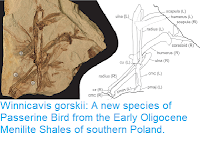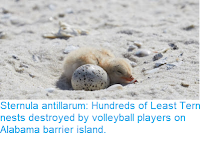The phenomenon of gigantism in island Birds is well documented, with examples such as the Dodo, Raphus cucullatus, of Mauritius, and Solitaire, Pezophaps solitaria, of Rodrigues (Giant Pigeons), the extinct Sylviornithidae of New Caledonia and Fiji, the Fiji Giant Ground Pigeon, Natunaornis gigoura, and a variety of Giant Waterfowl, Storks, Rails, Owls and Raptors from other islands. In many cases these Birds were early colonisers of small islands, where one of the first Birds to arrive typically evolved into a 'Giant Bird' niche. However the situation in New Zealand is more complex, with a large, complex ecosystem evolving in the absence of Mammals, which has produced a wide range of large Birds, including the extinct Moas, Waterfowl, Rails, and Eagles.
In a paper published in the journal Biology Letters on 7 August 2019, Trevor Worthy of the College of Science and Engineering at Flinders University, Suzanne Hand and Michael Archer of the PANGEA Research Centre at the University of New South Wales, and Paul Scofield and Vanesa De Pietri of the Canterbury Museum, describe a Giant Parrot from the Early Miocene St Bathans Fauna of South Island, New Zealand.
The St Bathans Fauna comes from a series of exposures of the lower Bannockburn Formation in the Otago Region of New Zealand. It comprises a suite of fossils laid down in a shallow lake between 19 and 16 million years ago. The lake was surrounded by a floodplain covered by subtropical vegetation including Casuarinas, Eucalypts and Palms as well as Podocarps, Araucarias and Southern Beeches. The fossiliferous layers have produced numerous disarticulated vertebrate remains, including Fish, Crocodylians, Squamates, and, most notably, Birds. These deposits are considered particularly important, as they record a time just after the Oligocene 'Great Drowning', when high sealevels left about 80% of New Zealand underwater, and is therefore thought to preserve an important stage in the assembling of the modern fauna of New Zealand.
The new species is named Heracles inexpectatus, where 'Heracles' honours the mythical Greek hero of the same name, for his slaying of Neleus, King of Pylos, after whom the largest Parrot previously known from the St Bathans Fauna to date was named, and 'inexpectatus' means 'unexpected'. The species is described from a partial left tibiotarsus and matching partial right tibiotarsus (the tibiotarsus is the lower leg bone of a Bird, the equivalent of the human shin. The describing of fossil Birds from leg bones alone is not unusual, as these are more robust than most of the Avian skeleton, and therefore more likely to be preserved.
Both of the preserved bones are incomplete, lacking the proximal and distal ends (top and bottom), but display a series of traits that enable them to be confidently assigned to a Parrot. These include a sulcus extensorius (deep groove) located near mid-shaft, a shaft that widens asymmetrically and flattens craniocaudally (downwards), a horizontally aligned and reduced pons supratendineus (groove at the base), large and prominent insertion scars for the transverse ligament with the distolateral scar close to the pons supratendineus.
The bones are exceptionally large and robust, with a minimum shaft circumference of 35.8 mm. Based upon this Worthy et al. suggest that the living Heracles inexpectatus, would have had a mass of about 6.96 kg, the equivalent of a small-to-medium Dog, and almost twice the mass of the Kakapo, Strigops habroptila, the largest living Parrot, and that like the Kakapo it was probably a large, ground-dwelling Bird.
See also...
In a paper published in the journal Biology Letters on 7 August 2019, Trevor Worthy of the College of Science and Engineering at Flinders University, Suzanne Hand and Michael Archer of the PANGEA Research Centre at the University of New South Wales, and Paul Scofield and Vanesa De Pietri of the Canterbury Museum, describe a Giant Parrot from the Early Miocene St Bathans Fauna of South Island, New Zealand.
The St Bathans Fauna comes from a series of exposures of the lower Bannockburn Formation in the Otago Region of New Zealand. It comprises a suite of fossils laid down in a shallow lake between 19 and 16 million years ago. The lake was surrounded by a floodplain covered by subtropical vegetation including Casuarinas, Eucalypts and Palms as well as Podocarps, Araucarias and Southern Beeches. The fossiliferous layers have produced numerous disarticulated vertebrate remains, including Fish, Crocodylians, Squamates, and, most notably, Birds. These deposits are considered particularly important, as they record a time just after the Oligocene 'Great Drowning', when high sealevels left about 80% of New Zealand underwater, and is therefore thought to preserve an important stage in the assembling of the modern fauna of New Zealand.
The new species is named Heracles inexpectatus, where 'Heracles' honours the mythical Greek hero of the same name, for his slaying of Neleus, King of Pylos, after whom the largest Parrot previously known from the St Bathans Fauna to date was named, and 'inexpectatus' means 'unexpected'. The species is described from a partial left tibiotarsus and matching partial right tibiotarsus (the tibiotarsus is the lower leg bone of a Bird, the equivalent of the human shin. The describing of fossil Birds from leg bones alone is not unusual, as these are more robust than most of the Avian skeleton, and therefore more likely to be preserved.
Tibiotarsi of Heracles inexpectatus, left, holotype (a), (b), (f ) NMNZ S.51083 and right, paratype (g), compared to (d), (e) left tibiotarsus of the modern Kakapo, Strigops habroptila (Canterbury Museum Av45277), in craniolateral (a) and cranial (b)–(g) views. (c) Silhouettes of a Human and Heracles inexpectatuss for scale. Scale bars are 20 mm. Abbreviations: ccl, crista cnemialis lateralis; cl, condylus lateralis; cm, condylus medialis; dtl, distal insertion scar for transverse ligament; fc, fibular crest; lfr, lateral scar for fibular retinaculum; lic, linea intermuscularis cranialis; mfr, mediocranial scar for fibular retinaculum; pons, pons supratendineus; ptl, proximal insertion scar for transverse ligament; se, sulcus extensorius; sf, sulcus m. fibularis; trf, tuberculum retinaculi m. fibularis. Worthy et al. (2019).
Both of the preserved bones are incomplete, lacking the proximal and distal ends (top and bottom), but display a series of traits that enable them to be confidently assigned to a Parrot. These include a sulcus extensorius (deep groove) located near mid-shaft, a shaft that widens asymmetrically and flattens craniocaudally (downwards), a horizontally aligned and reduced pons supratendineus (groove at the base), large and prominent insertion scars for the transverse ligament with the distolateral scar close to the pons supratendineus.
The bones are exceptionally large and robust, with a minimum shaft circumference of 35.8 mm. Based upon this Worthy et al. suggest that the living Heracles inexpectatus, would have had a mass of about 6.96 kg, the equivalent of a small-to-medium Dog, and almost twice the mass of the Kakapo, Strigops habroptila, the largest living Parrot, and that like the Kakapo it was probably a large, ground-dwelling Bird.
See also...
Follow Sciency Thoughts on Facebook.







